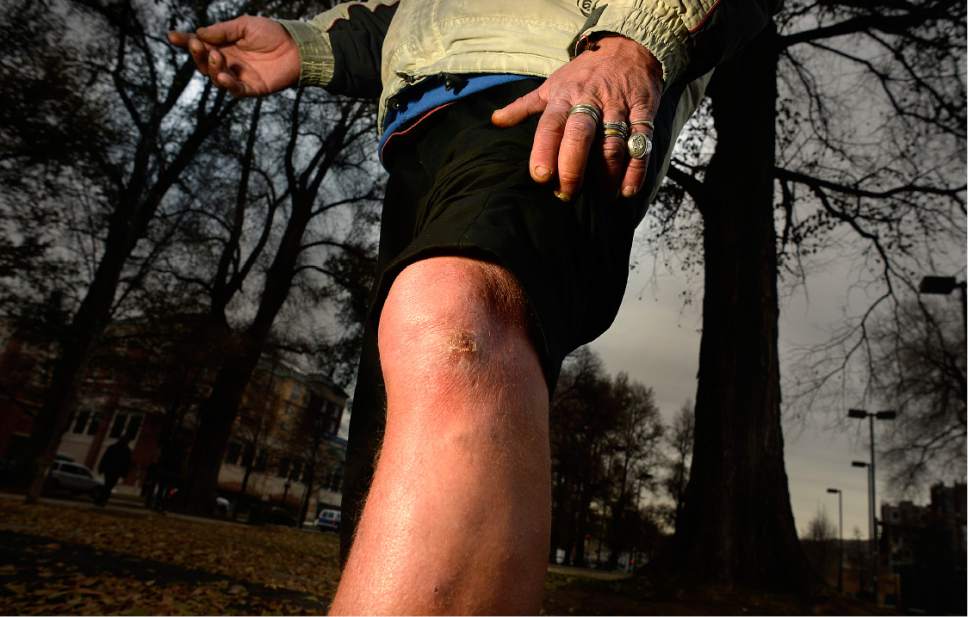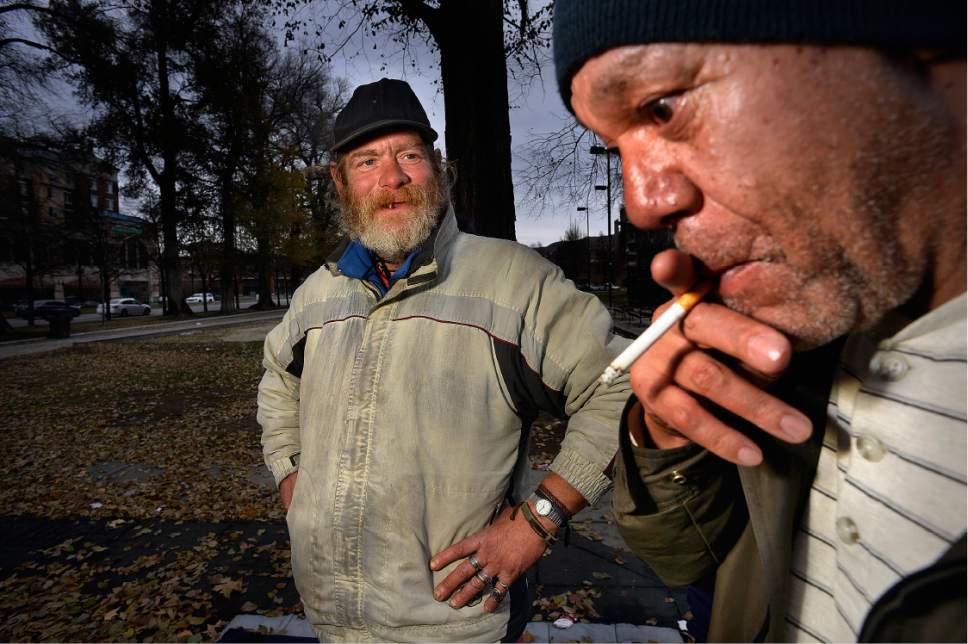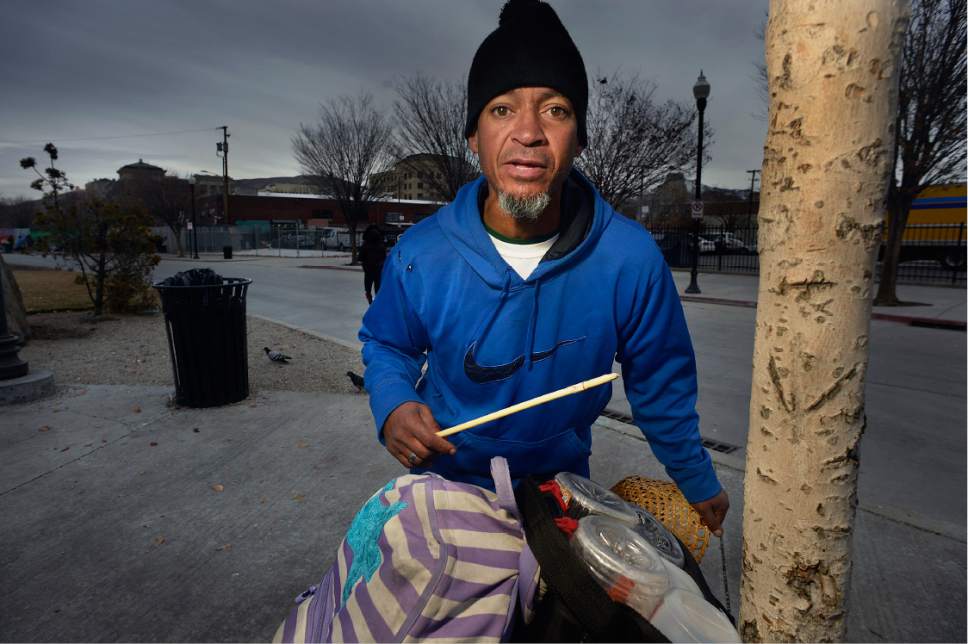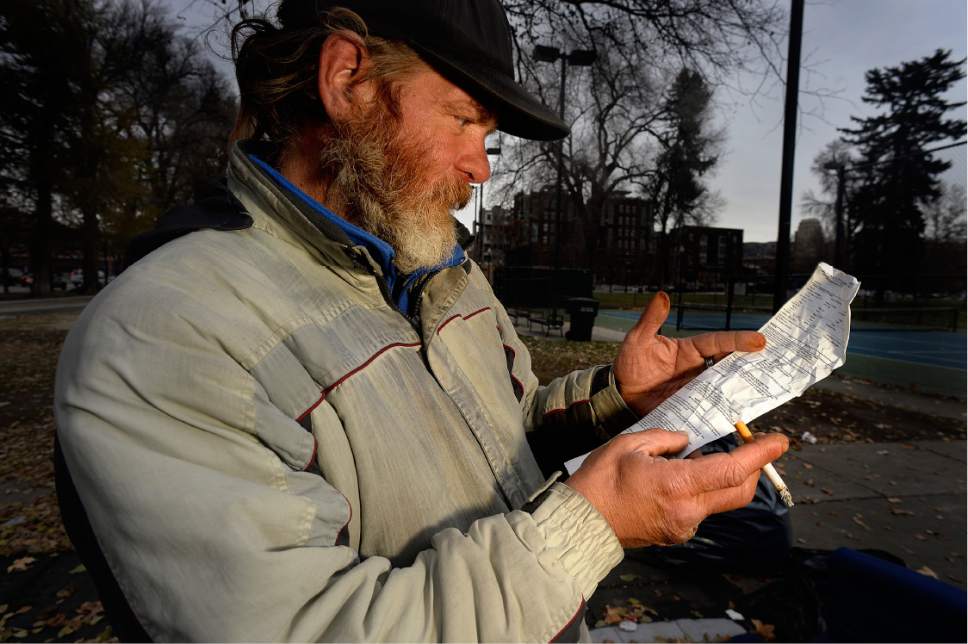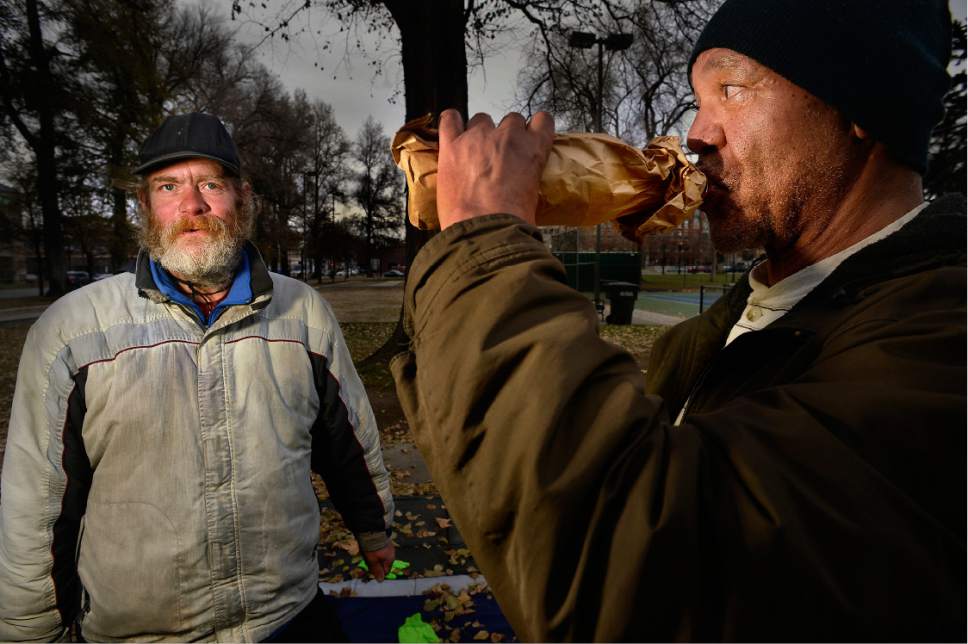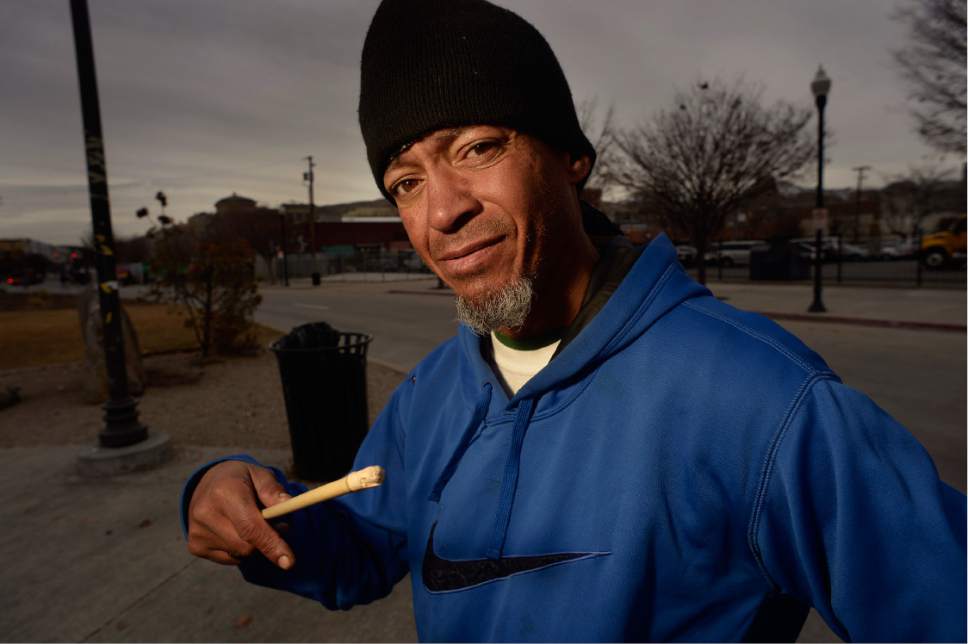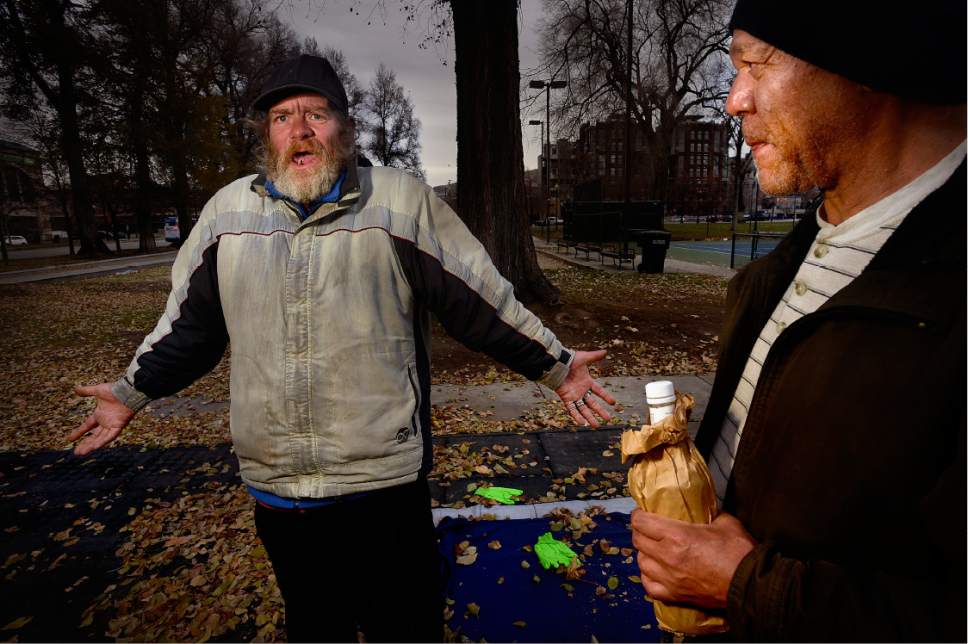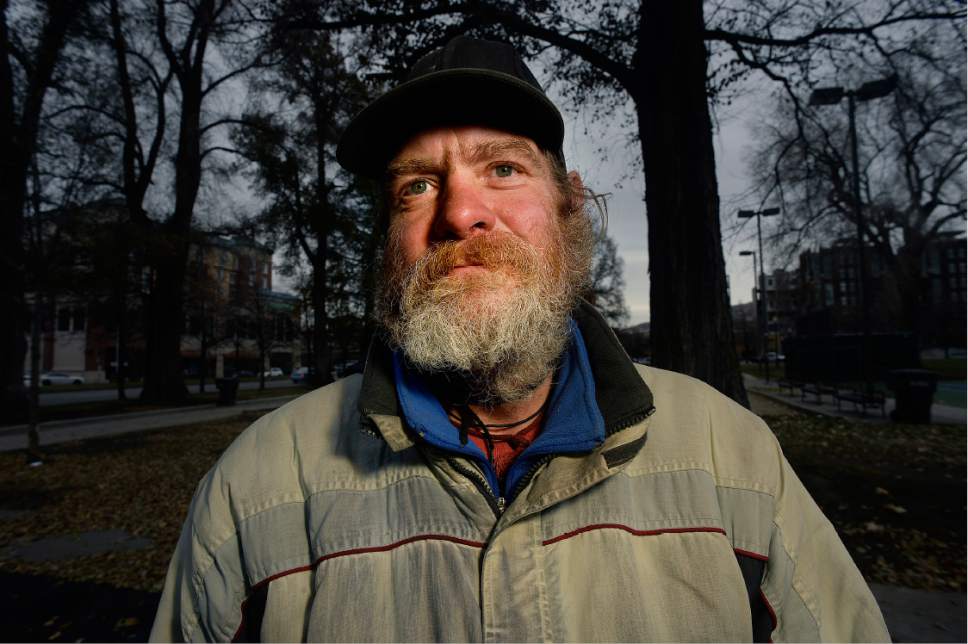This is an archived article that was published on sltrib.com in 2016, and information in the article may be outdated. It is provided only for personal research purposes and may not be reprinted.
Mike Hubertz is busy folding his nine fleece blankets and stuffing them into gray plastic garbage bags when his friend walks over.
"Michigan is Michigan," Saul Arrington tells him, but Hubertz was talking about Wisconsin.
The two men trade drags on a single cigarette and pass between them a glass bottle wrapped in a brown paper bag as they discuss where they came from and how they got here.
Hubertz stops disassembling his makeshift camp in Pioneer Park to tell Arrington it doesn't matter which state he was born in: He's not leaving Utah any time soon, and he certainly won't relocate to any of four new homeless shelters outlined by city officials Tuesday. This is his home.
That people choose such a lifestyle is a fear and a reality for the city and its residents. A transient population likely will remain in the Rio Grande District after the four shelters are built because homeless services, including Rescue Mission of Salt Lake and 4th Street Clinic, plan to stay in the area.
One of the new facilities will be just two blocks north and two blocks west of the crowded Road Home shelter — marked in recent months by stabbings and burglaries, and set to shut down when the four sites open. Add that to a bustling drug trade in Pioneer Park and it's unclear what impact Tuesday's announcement will have on the downtown hub.
"[Homeless] people are still going to be able to come and hang out," said Jonathan Harman, executive director of the Pioneer Park Coalition, an advocacy group for developers and shop owners.
Nevertheless, he hopes that the four shelters will spread the population among different neighborhoods, alleviating some of the pressure from the group concentrated in the Rio Grande District.
Harman concedes, though, that homeless services remaining in the area will complicate the issue, ushering people in for medicine and food during the day who may choose not to walk back to the new locations to sleep at night.
That the four shelters will be farther from services doesn't worry 4th Street Clinic, which provides health care for homeless people. The facility, located at 409 W. 400 South, won't relocate when the nearby Road Home leaves the neighborhood.
CEO Laura Michalski doesn't believe the shifting shelter locations will affect traffic to the clinic.
"Homeless people will still gravitate toward the downtown area," she said. "I don't think everybody is going to immediately leave."
The facility has invested $3 million over the past three years to renovate its space, including the addition of a dental center. A move, then, would be "not financially feasible," Michalski said.
Instead, 4th Street Clinic has applied for a grant that would fund a mobile clinic — what Michalski describes as a "rock star's RV" for health services — that would cover any gaps created by the four new shelters located throughout the city. The mobile facility, with a $450,000 price tag, could hold up to three exam rooms, a lab and some space for counseling.
City officials have said the new shelters, called "resource centers," will provide opportunities for some in-house services, meaning people wouldn't have to leave for every medical concern. That's not enough to entice Rescue Mission of Salt Lake to abandon its 40-year presence in the Rio Grande District.
Located at 463 S. 400 West, the facility anticipates "the same amount of service" even with the city's shelters moving the population elsewhere, said the faith-based organization's Eileen Crist. She also believes the rescue mission's recovery program will continue to "attract our homeless guests" and draw them downtown for aid.
Though Hubertz doesn't use the services often — going to 4th Street Clinic just three times over the past four years — the 47-year-old likes being close by when he needs an ibuprofen or a bandage.
He went to the facility last week for a cut on his left knee. With a toothy grimace, Hubertz revealed the wound by carefully pulling up the fabric of his pants. A health care worker quickly diagnosed it as a staph infection.
Hubertz has been living at Pioneer Park for the past four years. He prefers the freedom of being outside after time spent in jail.
"I'll take my chances at the park," he said, tugging on his white beard with a hand covered in silver rings. "As long as this park's here, they can't bump me into their new shelters."
Though police officers have kicked him out on several occasions, Hubertz returns to his spot at the park next to a swingset each night to avoid the bed bugs and stabbings he says plague other campsites.
Those problems don't bother Nathan Jacobson, 47, quite as much as the cold weather. After waking up Tuesday morning with a dusting of snow on top of his sleeping bag, Jacobson decided it was time to seek shelter at The Road Home for the winter.
He's been living on various downtown sidewalks for four years, hopping around West Temple for a bit before ending up on Rio Grande Street. A bad relationship, he said, left him destitute. Now he spends his days thrashing branches and tent pegs on a makeshift drum set of empty plastic bottles strapped to a rolling suitcase.
"I don't agree. I absolutely don't even agree a little bit," he sang to the beat as Angelica Fernandez walked away.
Before she left, biting a tinfoil-wrapped lunch, Fernandez had said she's "never seen a place so bad" as The Road Home. She's been there for the past four months. Jacobson, though, believes the facility is good enough for now and that being in the vicinity of homeless services is a plus: "I know a lot of them. I use a lot of them."
He doesn't plan to move to one of the new shelters when they're completed in about two years — "I won't be homeless then."
For now, pigeons flutter around his camp, closing in on Jacobson's can of Pepsi that sits on the concrete. "It's OK. We're OK," he yells at a police car rolling by.
Twitter: @CourtneyLTanner


